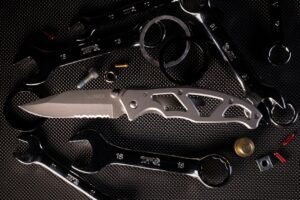Pliers are an essential tool for any do-it-yourself (DIY) enthusiast. They come in a variety of types, each designed for specific tasks. The most common types of pliers include:
1.
Needle-Nose Pliers: These pliers have long, narrow jaws that taper to a point, making them ideal for reaching into tight spaces and gripping small objects. They are commonly used for electrical work, jewelry making, and other precision tasks. 2.
Slip-Joint Pliers: These versatile pliers have an adjustable pivot point that allows the user to switch between different jaw widths. They are great for gripping and turning objects of various sizes, making them a must-have for general DIY projects. 3.
Lineman’s Pliers: Also known as combination pliers, these heavy-duty tools feature a cutting edge near the pivot point, making them perfect for cutting wires and cables. They also have a gripping area for holding and twisting objects, making them essential for electrical work. 4.
Locking Pliers: These pliers have a built-in locking mechanism that allows them to clamp onto an object and hold it in place without the need for constant pressure from the user. This makes them perfect for holding materials together while glue dries or for gripping onto rounded or irregularly shaped objects. 5.
Tongue-and-Groove Pliers: Also known as channel-lock pliers, these tools have serrated jaws that can be adjusted to different widths, allowing them to grip onto a wide range of objects. They are commonly used for plumbing tasks, such as tightening or loosening pipe fittings. Each type of pliers has its own unique features and uses, making it important to have a variety of pliers in your DIY toolkit to tackle different projects effectively.
Key Takeaways
- Essential types of pliers for DIY projects include needle-nose, slip-joint, and cutting pliers
- When choosing pliers, consider the size and material that best suits the task at hand
- Proper techniques for using pliers safely include wearing eye protection and using the right tool for the job
- Common DIY projects that require pliers include electrical work, jewelry making, and plumbing repairs
- To maintain and care for your pliers, keep them clean, lubricated, and store them in a dry place
Choosing the Right Size and Material for Your Pliers
Size Matters
The size of the objects you will be working with is a crucial consideration. For smaller, more delicate tasks such as jewelry making or electronics repair, you will want to choose smaller, more precise pliers, such as needle-nose or fine-tip pliers. On the other hand, for larger tasks such as automotive repair or construction, you will need larger, heavy-duty pliers, such as lineman’s or tongue-and-groove pliers.
Material Quality
In addition to size, the material of the pliers is also important. Most pliers are made from steel, but the quality of the steel can vary. Look for pliers made from high-quality steel that is durable and resistant to rust and corrosion. Some pliers also have insulated handles, which can be important for electrical work to prevent shock.
Ergonomics and Comfort
It’s also important to consider the ergonomics of the pliers. Look for pliers with comfortable grips that are easy to hold and use for extended periods of time. Some pliers also have features such as spring-loaded handles or cushioned grips to reduce hand fatigue.
Ultimately, the right size and material for your pliers will depend on the specific tasks you will be using them for. It’s a good idea to have a variety of pliers in different sizes and materials to cover a wide range of DIY projects.
Proper Techniques for Using Pliers Safely

Using pliers safely is essential to prevent injury and damage to your workpieces. Here are some proper techniques for using pliers safely: 1. Choose the right type of pliers for the task at hand.
Using the wrong type of pliers can lead to damage to the tool or the workpiece. 2. Always wear safety goggles when using pliers to protect your eyes from flying debris or sharp objects.
3. Use the pliers only for their intended purpose. Do not use them as a hammer or pry bar, as this can damage the tool and cause injury.
4. Keep your fingers away from the jaws of the pliers when using them to avoid pinching or crushing injuries. 5.
Use the proper grip on the handles of the pliers to maintain control and prevent slipping. 6. When cutting with pliers, position the cutting edge at a 90-degree angle to the wire or cable being cut to ensure a clean cut and prevent damage to the tool.
7. Store your pliers in a safe place when not in use to prevent damage and keep them out of reach of children. By following these proper techniques for using pliers safely, you can ensure that you complete your DIY projects without injury or damage to your tools.
Common DIY Projects That Require Pliers
| Project | Materials Needed | Difficulty Level |
|---|---|---|
| Replacing a Faucet | New faucet, pliers, wrench | Intermediate |
| Fixing a Leaky Pipe | Pipe sealant, pliers, pipe wrench | Intermediate |
| Installing a Light Fixture | Light fixture, wire nuts, pliers | Beginner |
| Assembling Furniture | Furniture pieces, screws, pliers | Beginner |
Pliers are an essential tool for a wide range of DIY projects. Some common DIY projects that require pliers include: 1. Electrical Work: Pliers are essential for bending and shaping wires, as well as cutting and stripping insulation from electrical cables.
2. Plumbing: Pliers are often used to tighten or loosen pipe fittings, as well as grip onto pipes and other plumbing fixtures. 3.
Automotive Repair: Pliers are useful for gripping and turning nuts and bolts, as well as cutting wires and cables. 4. Jewelry Making: Pliers with fine tips are essential for bending and shaping metal wire and small components.
5. Home Improvement: Pliers are useful for a wide range of tasks around the home, such as gripping and turning screws, nails, and other fasteners. 6.
Crafting: Pliers are essential for a variety of crafting projects, such as making chainmaille jewelry or assembling small components. No matter what DIY project you are working on, chances are you will need a pair of pliers at some point. Having a variety of pliers in your toolkit will ensure that you have the right tool for the job.
Tips for Maintaining and Caring for Your Pliers
Proper maintenance and care are essential for keeping your pliers in good working condition. Here are some tips for maintaining and caring for your pliers: 1. Keep your pliers clean and free from dirt and debris by wiping them down after each use.
2. Lubricate any moving parts on your pliers regularly to prevent rust and corrosion. 3.
Store your pliers in a dry place to prevent rust and corrosion. 4. Inspect your pliers regularly for signs of wear or damage, such as worn jaws or loose pivot points, and replace them if necessary.
5. Sharpen the cutting edges on your pliers regularly to ensure clean cuts and prevent damage to the tool. 6.
Use your pliers only for their intended purpose to prevent unnecessary wear and damage. By following these tips for maintaining and caring for your pliers, you can ensure that they remain in good working condition for years to come.
Advanced Plier Techniques for Mastering DIY Projects

Shaping and Forming
Some advanced plier techniques include double bending, which involves making two bends close together in a piece of wire or metal rod using needle-nose or flat-nose pliers. This technique is commonly used in jewelry making and metalworking. Another technique is forming loops, which involves using round-nose pliers to create perfect loops in wire or metal rod for jewelry making or other crafting projects.
Wire Working
Wire wrapping is another advanced technique that involves wrapping wire around itself or another object to create decorative or functional designs. Round-nose pliers are commonly used for this technique.
Locking Pliers and Cutting Techniques
Locking pliers can be used in creative ways, such as clamping onto irregularly shaped objects or acting as a makeshift vise when working with small components. Mastering different cutting techniques with lineman’s or diagonal-cutting pliers can make tasks such as cutting wires or cables more efficient and precise.
By mastering these advanced plier techniques, you can take your DIY skills to the next level and tackle more complex projects with confidence.
Troubleshooting and Problem-Solving with Pliers
Pliers can also be used for troubleshooting and problem-solving in various DIY projects. Here are some common problems that can be solved with pliers: 1. Removing Stripped Screws: If a screw head becomes stripped, locking pliers can be used to grip onto the head and turn it out.
2. Extracting Nails: If a nail becomes stuck or bent, locking pliers can be used to grip onto the nail head and pull it out. 3.
Holding Objects Together: Locking pliers can be used to hold materials together while glue dries or while waiting for another fastening method. 4. Gripping onto Rounded Objects: Tongue-and-groove pliers can be adjusted to grip onto rounded or irregularly shaped objects that other types of pliers may struggle with.
5. Straightening Wires: Needle-nose or flat-nose pliers can be used to straighten bent wires or metal rods before further manipulation or use. By using your pliers creatively and thinking outside the box, you can solve a wide range of problems that may arise during DIY projects.
In conclusion, having a variety of high-quality pliers in your DIY toolkit is essential for tackling a wide range of projects effectively and safely. By choosing the right type, size, and material of pliers, using them safely and effectively, maintaining and caring for them properly, mastering advanced techniques, and using them creatively for troubleshooting and problem-solving, you can become a master DIY enthusiast with the power of pliers at your fingertips!
Check out this article on the West Indies demolishing England in Bridgetown Blitz to see how a powerful tool like pliers can be compared to the dominant performance of Andre Russell in the cricket match. Just as pliers are essential for gripping and twisting, Russell’s performance was crucial in securing the victory for the West Indies team.
FAQs
What are pliers?
Pliers are hand tools used to grip, turn, and bend objects. They typically have two handles and a pair of jaws at the end.
What are the different types of pliers?
There are various types of pliers, including slip-joint pliers, needle-nose pliers, cutting pliers, locking pliers, and combination pliers.
What are pliers used for?
Pliers are used for gripping, bending, cutting, and turning objects. They are commonly used in construction, electrical work, and automotive repair.
How do pliers work?
Pliers work by using leverage to grip and manipulate objects. The handles provide the force needed to operate the jaws, allowing the user to perform various tasks.
What materials are pliers made of?
Pliers are typically made of steel or other durable metals. The handles may be coated with rubber or plastic for a more comfortable grip.
How do I choose the right pliers for my needs?
When choosing pliers, consider the specific task you need them for. Different types of pliers are designed for different purposes, so it’s important to select the right tool for the job.




















+ There are no comments
Add yours